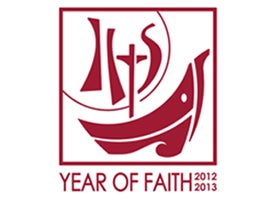Defining and keeping the Christian Faith in the Church
(A reflection on Porta Fidei)
 |
In the 1500s, the
Catholic Church had finally reformed herself after a long struggle of reform.
Reforms at the ranks and at below were unsuccessful since there was no
universal desire to undergo such change. Reform had been separately dealt by
few secular clergy, few temporal rulers, few religious congregations and
others. However, in 1545 the Catholic Church had finally settled the struggle
of reform after the havoc and distortions that had been caused by the
Protestant Reformation. The Ecumenical Council of Trent was primarily a
reaction against the controversies and inquiries raised by Martin Luther and
his followers. In the first phase of the Council, 1545-1547, one of the issues
discussed was the opposition of Luther against the source of faith. For Luther
there is only one source that is the Holy Scripture or Sola Scriptura. However, the Church responded to it that there is
only one source or deposit of faith. It was revealed to mankind and channeled
into two ways, Sacred Scripture and Sacred Tradition. Trent did not cater the
two-source theory that was being accused of to the Church. This is one of the
significance of Trent in the history of the Church by defining finally through
a decree. Nevertheless, faith was kept in this matter into two ways, Sacred
Scripture and Sacred Tradition.
On October 11, 2011
Pope Benedict XVI wrote the Muto Propio,
Porta Fidei, by declaring a Year of Faith
starting October 11, 2012. He called for a year of faith at the anniversary of
the convocation of the Vatican Council II in 1962. He wrote some of his personal
reasons on why he declared a year of Faith, “It
often happens that Christians are more concerned for the social, cultural and
political consequences of their commitment, continuing to think of the faith as
a self-evident presupposition for life in society.” (Porta Fidei, 2). He further adds that in reality, this
presupposition has been openly denied. At the same time, he had convoked for a
Synod of Bishop on that same day on October 11, 2012 to rediscover and reflect
faith using the documents of Vatican II as the point of departure in the synod.
He gave the theme, “The New
Evangelization for the Transmission of the Christian Faith”. Benedict XVI
also believes in the same purpose of Paul VI, his venerable predecessor, to
declare another Year of Faith in order for all Christians to have the “exact knowledge of the faith, so as to
reinvigorate it, purify it, confirm it, and confess it” (Porta Fidei, 4). Nevertheless, in
context with the realities of the 21st century, the Church tries to
find ways on how faith should be kept by looking for new evangelization and how
Christian faith should be transmitted to people.
Our
faith has been defined already long since the foundation of Christian faith
through our Lord, Jesus Christ, but it was later only proclaimed and clarified
in Trent. However, knowledge on faith wasn’t enough to make people live a
holier and fulfilled Christian life that until now it is still the constant
call of the Church. Keeping the faith is nonetheless the need to be addressed in
the Synod of Bishops of October 2012 calls for.
This
faith then that we constantly yearn for is “to profess faith in the Trinity –
Father, Son and Holy Spirit – is to believe in one God who is Love (cf. 1 Jn
4:8): the Father, who in the fullness of time sent his Son for our salvation;
Jesus Christ, who in the mystery of his death and resurrection redeemed the
world; the Holy Spirit, who leads the Church across the centuries as we await
the Lord’s glorious return.” (Porta
Fidei, 1).

No comments:
Post a Comment